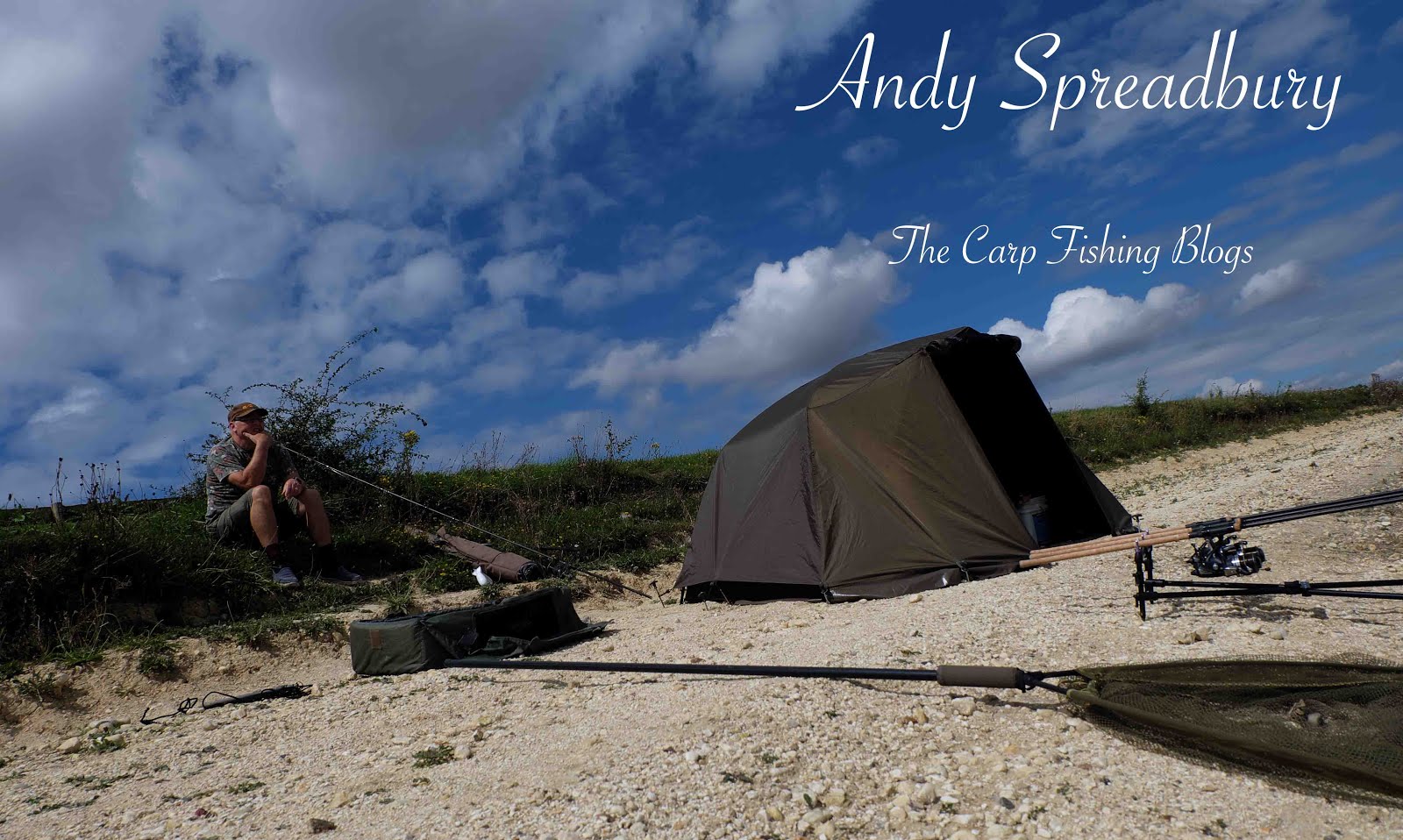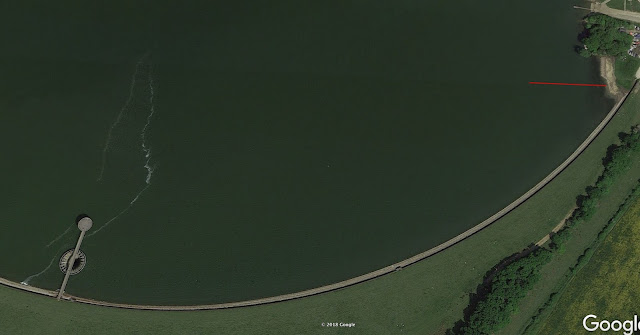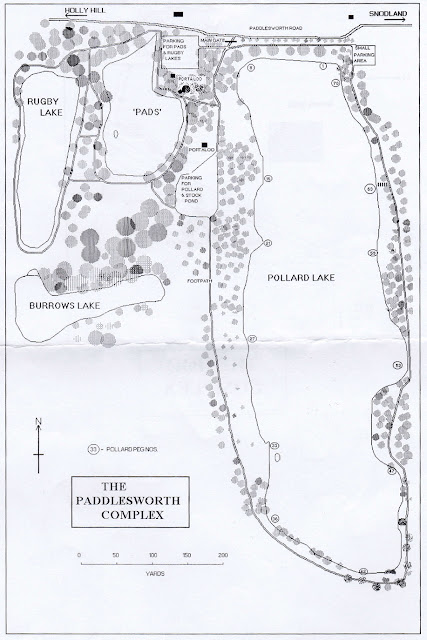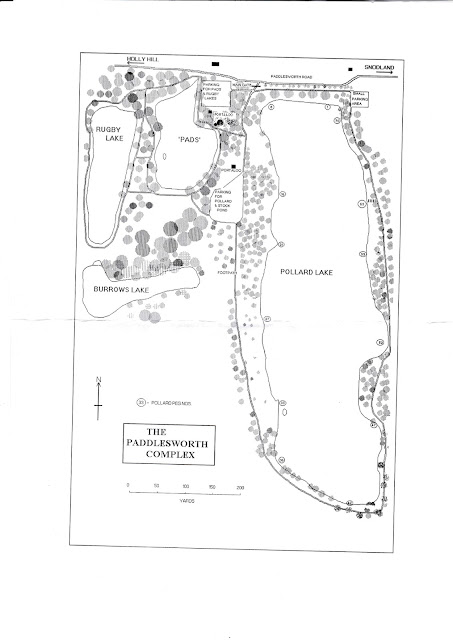Saturday, 21st.July
After I packed up at the end of the last session and loaded up the barrow, I decided to investigate the area down by the Dam to my left. The Dam encompasses the southern end of the reservoir where the Draw-Off Tower is located and Google Earth images show the effects of the aeration system. This is manifested by surface disturbance some distance out from the Draw-Off Tower.Drinking-water supply reservoirs use something called Hypolimnetic Aeration and Oxygenation. The scientific basis for this is somewhat complex and beyond the scope of my ramblings - but as far as I’m concerned it’s an Aerator to get more oxygen into the water. This is good news for both fish and anglers as it provides a significant feature to go at.
One possible strategy would be to try and fish as close to the aerated water as possible on the basis that the oxygenated water is an obvious ‘draw’ for the fish. In hot weather, artificially oxygenated water is almost a sure-fire ‘banker’ and carp will be located nearby. However, I hate fishing on concrete and don’t really relish bivvy-ing up on the Dam, even if it does offer opportunities; so anywhere that accesses the general area is good enough for me.
There is another reason for not having to fish on the concrete. To be effective, the aeration system has to cover a wide area of the reservoir’s surface so oxygenation has to be widespread and this almost certainly means the whole of the southern end will be affected.
The red line on the Google image indicates an 80 yard cast aimed at the end of the dam on the far bank and it is this trial cast I made before I left, pleased to find the smooth, soft-ish bottom I was hoping for. This is where I shall fish next time.
The above image shows the Aeration System at Newman Lake, Washington State, USA and is taken from a paper “Aeration and Oxygenation Methods for Stratified Lakes and Reservoirs” by Barry Moore, Mark Mobley, John Little, Bob Kortmann, and Paul Gantzer.
Of particular interest is that it shows the Epilimnion and Hypolimnion of Newman Lake. I imagine a similar scenario exists for Bough Beech in Kent. The significance of this is - and I refer to Wikipedia for this - ‘The epilimnion or surface layer is the top-most layer in a thermally stratified lake, occurring above the deeper hypolimnion. It is warmer and typically has a higher pH and higher dissolved oxygen concentration than the hypolimnion.’
‘Typically the hypolimnion is the coldest layer of a lake in summer, and the warmest layer during winter. Being at depth, it is isolated from surface wind-mixing during summer, and usually receives insufficient irradiance (light) for photosynthesis to occur.
‘In deep, temperate lakes, the bottom-most waters of the hypolimnion are typically close to 4 °C throughout the year. The hypolimnion may be much warmer in lakes at warmer latitudes.’ [Probably is warmer at Bough Beech].
The paper to which I refer also gives data as to where the Thermocline (the interface between the Epilimnion and Hypolimnion and level of sudden temperature change - shown in the Bar Chart above) is. Although this data refers specifically to a lake in the USA, I would take a guess that a similar scenario exists for most deep lakes and reservoirs in similar climatic regions.
In the years 2008 to 2014 it can be seen that the depth of the Thermocline is between 4 and 6 meters (approximately 13 to 20 feet although slightly shallower in previous years). The important thing about this is that it indicates the depth of the warm upper layer; in hot weather (such as we have had recently) it may be too warm and the fish may go below it to seek cooler conditions.
I offer this as background information as to why I choose to fish the deeper water rather than the shallows - taking into account the ‘Principles’ I outlined in my previous Blog. An 80 yard cast in the location indicated on my Google Earth image puts me into water in this order of depth.
I found an excellent tutorial explaining all about thermal stratification on YouTube by Stan Gregory found here: Here
There are two videos in the tutorial and I found of particular interest the description (I think it’s in video two) of how the upper, warmer layer tilts in response to wind direction. This supports fishing into the wind during the summer - but on the back of the wind in the winter.
Tuesday, 31st.July
Bough Beech, Car Park Corner
13.15Bit of a late start due to having to make ‘phone calls for our imminent house move. I cannot believe how long it takes to arrange insurances over the ‘phone - they want to know all the proverbial ‘ins and outs of a duck’s bottom’. Boy can those people talk! Lost the will to live after the first thirty minutes of suffering their ‘spiel’! Anyway…
After the recent roasting weather (during which I have suffered considerably, I haven’t even contemplated going fishing) we had a much longed-for storm first thing this morning. Thunder, lightening - the ‘full monty’. If there’s one thing to get the fish going after hot weather, then it’s a good storm so I felt really confident setting up on ‘The Beach’ in Car Park Corner.
Following last time’s late survey, I banged out three baits in the direction of the end of the dam - the red line shown on my Google image. One to the left, one to the right. After watching Stan Gregory’s YouTube tutorials, I feel I have a real ‘feel’ for how the thermocline is behaving today. The wind is angling in to this bank and I can almost sense the warmer, upper layer of water piling up on this shore. What I particularly liked about the videos was that it showed how this Epilimnion tilts and oscillates back and forth cyclically. This would definitely account for specific feeding spells on deep lakes as the area the carp prefer to be in, oscillates to and fro across the lake in a specific rhythm.
Does this knowledge help you catch fish though? It’s all very well having an understanding of the science behind thermal stratification in deep lakes, but unless it helps you catch carp in a practical sense, it’s little more than background knowledge.
If nothing else, it explains why it is favourable to fish into the wind in summer and on the back of the wind in the winter. Unfortunately, (or fortunately, depending on how you look at it) carp are not that predictable. It does help in decision-making and anything that helps in eliminating the ‘randomness’ from carp fishing has to be a good thing.
13.50
At last I am fishing with bait I have confidence in - ‘Cherry Carp KMT’ in 18mm. Described as an ‘old school’ Fishmeal, it ticks all the boxes and I just know it’s going to catch fish.
This is one of Cherry Carp’s range of Shelf Life baits which you can turn into ‘fresh’ bait with their H-Dec Neutraliser. This stuff neutralises the preservative in the bait and releases the natural amino-acids. Don’t ask me any more! I don’t go near bait science any more these days; there is only one criterion I have that is a requirement in a bait - “does it catch carp?” If it does then it’s good enough for me. There’s too much other stuff to worry about without getting one’s knickers in a twist worrying about palatability, nutritional content, digestibility, and a hundred and one other factors which may or may not have any relevance at all! People I know use it and that’s good enough for me! This one has a detectable squid pong about it and if I was a carp I’d be going mental for it. As I believe I am not a carp I’ll settle for just throwing it at them!
15.00
Sometimes you know instinctively that you’ve got things right and I’ve got that feeling right now. I may be way off the beam here and putting the proverbial ‘mockers’ on things, but it feels right. It’s not just the bait - I’m using a different rig.
I watched the latest ‘Monster Carp’ show. This is the one where they catch a disgracefully huge number of massive carp from a lake in Bosnia (I think). No matter.
I long since stopped trying to copy the rigs and baits the Korda boys use (although I have no doubt that it would be successful to do so), but they did come up with a good rig suggestion which I am using today. The ‘Spinner’, or ‘Ronnie’ rig.
Now I have a confession to make… I have in the past blatantly copied the Korda boys (and others) in terms of their rigs and baits in the forlorn hope that by fishing as they do I could somehow inherit their success by proxy. Rookie error. It is of course not as simple as pure imitation (although the thinking is sound enough to a limited extent).
In past blogs I have outlined my thinking on rigs, namely that I try to enable an initial pick-up off the bottom of the lake in the first instance by means of a flexible last couple of inches and in this regard I used a combi-rig as a hinge. I mentioned that a recent experience with stiff rigs (stiff material all the way through) whilst acting with some (dubious) degree of anti-eject, also prevented the bait from being sucked up in the first place - if it’s difficult to blow out - then it’s difficult to suck in. I made the point that if the fish are feeding with any confidence at all then it probably doesn’t make much difference - we’ve all caught carp on stiff rigs and they are very effective - but I did describe an experience I had in France where I believed the fish weren’t really having it and I suffered a succession of hook-pulls.
The ‘Spinner’ combines the stiffness of the boom, with the ‘hinge’ at the ring swivel and enables an ‘easier’ pick-up of the bait from the bottom, the hook aligning in the vertical plane and catching in the bottom lip. Although designed and intended for pop-ups, it works just as well with bottom baits and it was this rig with which the Korda boys were catching on the show. And on what I hope I will catch here.
16.10
Playing around with rigs again and I’ve tied this up. Yes, it’s a chod rig - but it’s intended for a bottom bait. It’s slightly longer than the ‘Ronnie’ and this is deliberate. The intention is to increase the the length of the ‘lever arm’ - the hinged section attached to the hook. The aim is to slightly increase the vertical height a carp can suck the bait off the bottom before the weight of the ring swivel comes into play. This will help align the hook in the vertical plane.
I note however that it is reported “hook holds can be all over the place” with a Ronnie and bottom bait combo.
The other point is that it is tied up ‘D rig’ style. The conventional Ronnie has a hook bead of which I have never been a fan; I find the weight of the bait on a forceful cast tends to make everything slip round the bend of the hook - the bait following it and positioned off the bend instead of the shank. Shank-aligned is to be much preferred to bend-aligned which puts the point of the hook in a ‘chinese snooker’ and less likely to hook-up on the take. I have had fish fall off with a bait mounted like this.
18.00
Just had a Bream on the left-hand rod whilst cooking the tea. I think I’ll take this opportunity to change the Ronnie for a Choddy as just as I predicted, the hook beads slipped around the bend of the hook.
18.40
The boom material I am using is Gardner ‘Trick-Link’. This is deadly stuff; it’s like wire. It springs about all over the place in my tackle bag in great coils which snag on everything. It feels like ‘Amnesia’ which I think I shall go on when this spool runs out.
Left the centre rod on the Ronnie. I removed the hook bead that came with it (actually, a piece of small bore tube) and replaced it with a Fox hook bead. This seemed to hold a bit better so I think I shall use this instead.
19.00
Fantasies. I know of no carp angler who does not fantasise about catching a PB (Personal Best). If one cannot go fishing, then thinking about it is the next best thing, and in the wee small hours when the household is asleep, thoughts naturally turn to not only catching carp, but seeing a great expanse of golden flank roll over the net. In my mind I see the great fish in the bottom of the folds and when I un-ship the net arms and roll up the mesh I find the damn thing is so huge I cannot lift it from the water!
Ah, dreams… What would we do without our dreams and fantasies?
We probably wouldn’t be who we are.
19.30
Another Bream which (fortunately) fell off under the rod-tip. If the Bream are finding my single baits plus three-bait stringer, then I’m sure the carp can.
20.30
Target fish. Known fish already caught which act as an inspiration to those fishing the water. On here, probably the number one target fish is a forty-five (caught this year) but long time members are adamant there are uncaught fish even bigger. For myself, my target is anything over thirty-five. I know of a definite thirty-seven common and I guess this fish is top of my list. Forties I can only dream about!
It is a matter of intense personal shame that my own UK PB has stood at thirty-four twelve for forty-one years. Yes, forty-one years! True, I haven’t been trying to beat it in all that time and I have fished few waters capable of producing fish of that size, but I still find it irksome to say the least that I haven’t broken it - or got near it, in all that time. I caught a thirty-four last year (or was it the year before that? Can’t remember) - but when I had it, it only weighed thirty-one!
Are we kidding ourselves when we say these personal targets don’t really matter? That we are only here for the fishing and the PBs are irrelevant? It seems to matter at the moment and I think it’s something to do with the fact I know they are in here. If they are swimming around out there then they are catchable.
But what must I do to get one?
Wednesday, 1st.August
07.00Really cold, silent, night, and a heavy mist when I awoke this morning. Inside of the bivvy dripping with dew.
I have to get out and have a wee four or five times during the night, the result of an old man’s prostate. It was freezing! Forgot to bring my fleece so had to sleep in just a tee-shirt. Must have got lost in all the packing in the house-move.
There are rafts of algae in the margins (some of it the blue-green stuff) this morning; I see they have stuck a notice on the gate warning to steer clear of it. I’ve heard it can kill sheep so better try and not have any contact. The ducks seem quite happy to splash about in it so I guess they must have some kind of immunity.
Not a thing last night, not even a bleep from a Bream although I had another one as I was packing-up this morning. It was still, quiet, and cold.
I don’t actually think there are any carp in Bough Beech. It’s all damn lies to get our subscription money!
It seems like that anyway…
Don’t know when I shall be able to get out fishing again; we move house next Thursday and there is such a lot of work to do. See you soon…












Comments
Post a Comment